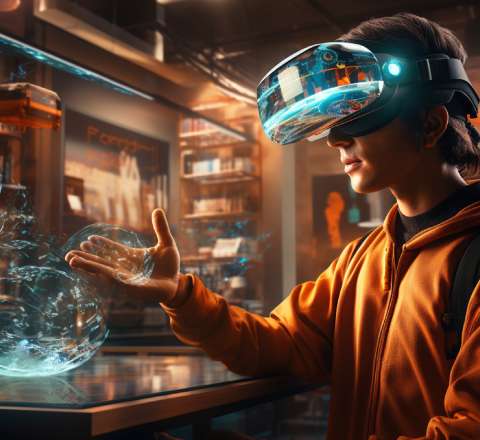
Web Design for the Future: Preparing for the Rise of Augmented Reality (AR)
The world of web design is constantly evolving, with new technologies and trends reshaping how we create and experience digital content. One of the most exciting developments on the horizon is the rise of Augmented Reality (AR). As AR technology becomes more accessible and integrated into everyday life, it’s poised to revolutionize web design, offering new ways to engage users and enhance their online experiences.
But what exactly is AR, and how can web designers prepare for its inevitable impact? In this article, we’ll explore the potential of AR in web design and offer practical tips on how to get ahead of this transformative trend.
What is Augmented Reality (AR)?
Augmented Reality (AR) is a technology that overlays digital information—such as images, sounds, or other data—onto the real world, typically through a smartphone or AR glasses. Unlike Virtual Reality (VR), which creates entirely immersive digital environments, AR enhances the physical world by adding interactive elements.
From virtual try-ons in e-commerce to interactive learning experiences, AR has already begun to change how users interact with digital content. As AR continues to grow, web designers will need to adapt to incorporate this technology into their designs.
Why AR is the Future of Web Design
1. Enhanced User Engagement
• AR offers a more immersive and interactive experience than traditional web design. By integrating AR elements, websites can engage users on a deeper level, making interactions more memorable and impactful.
2. Personalized Experiences
• AR allows for highly personalized user experiences. For example, users can see how a piece of furniture would look in their living room before buying it, or explore a product in 3D from the comfort of their home. This level of personalization can lead to higher conversion rates and increased customer satisfaction.
3. Bridging the Gap Between Online and Offline
• AR blurs the lines between online and offline experiences, creating seamless transitions. This can be particularly valuable in retail, education, and real estate, where users can interact with products or environments in a way that closely mimics real life.
Preparing Your Web Design for AR
As AR technology continues to evolve, web designers need to be ready to incorporate these experiences into their websites. Here’s how you can prepare:
1. Understand AR Capabilities and Limitations
• Before diving into AR design, it’s crucial to understand what AR can and cannot do. AR is still a relatively new technology, and its capabilities are rapidly expanding. Stay informed about the latest AR developments, tools, and platforms to ensure you’re designing within the technology’s current limitations while anticipating future possibilities.
2. Start with Mobile-First Design
• Given that most AR experiences are currently accessed via smartphones, it’s essential to prioritize mobile-first design. Ensure your websites are fully responsive and optimized for mobile devices, as this will lay the foundation for seamless AR integration.
3. Incorporate 3D Elements and Models
• AR often involves 3D objects and environments. To prepare for AR, start incorporating 3D elements into your designs. Tools like WebGL and Three.js can help you create interactive 3D content that can be easily adapted for AR experiences.
• Consider offering virtual product try-ons, interactive 3D models, or spatial visualizations. For example, an online clothing store could use AR to let customers see how an outfit looks on them before making a purchase.
4. Leverage WebAR
• WebAR refers to AR experiences that are delivered directly through a web browser, without the need for a dedicated app. As WebAR technology improves, it’s becoming a viable option for web designers. Start experimenting with WebAR to create lightweight, accessible AR experiences that can reach a broader audience.
• Platforms like AR.js and 8th Wall allow developers to build AR experiences that work directly in web browsers, without requiring users to download any additional apps. This makes it easier to integrate AR into your website, offering a seamless experience for users.
5. Focus on Performance Optimization
• AR experiences can be resource-intensive, so optimizing your website’s performance is critical. This includes minimizing file sizes, optimizing code, and ensuring fast load times. A well-optimized site will not only enhance the AR experience but also improve overall SEO and user satisfaction.
• Since AR requires real-time interaction, your website needs to be fast and responsive. Optimize your site’s performance by compressing files, reducing server requests, and using a Content Delivery Network (CDN) to ensure quick load times.
6. Design for Accessibility
• Just as with traditional web design, accessibility should be a priority in AR design. Ensure that AR experiences are accessible to all users, including those with disabilities. This might involve providing alternative ways to access content, using descriptive alt text for AR elements, or ensuring that AR interactions are navigable via keyboard and screen readers.
The Future is AR-Ready
As AR technology continues to advance, the possibilities for web design are virtually limitless. By preparing now, you can position your web design company at the forefront of this exciting trend. Not only will you be able to offer your clients cutting-edge AR experiences, but you’ll also be contributing to the evolution of the web as we know it.
AR is not just a passing fad—it’s a glimpse into the future of digital interaction. By staying ahead of the curve and incorporating AR into your web design strategy, you can create immersive, engaging, and innovative experiences that set your brand apart from the competition.
Conclusion
The rise of Augmented Reality is set to transform web design, offering new ways to engage users and create more personalized, interactive experiences. By understanding AR’s potential, experimenting with WebAR, and focusing on performance and accessibility, your web design company can prepare for the future and lead the way in creating the next generation of digital experiences.
Now is the time to start exploring AR in web design. Whether it’s through 3D product displays, virtual try-ons, or immersive storytelling, the possibilities are endless. Get ready to elevate your web design projects with the power of AR and create experiences that leave a lasting impression.


